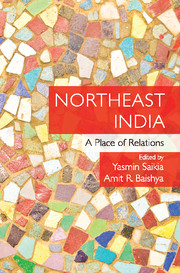Book contents
- Frontmatter
- Contents
- List of Figures
- List of Boxes
- List of Tables
- Acknowledgments
- Introduction
- Section I Contemporary Politics and Issues of Definition
- Section II Creating Presence
- 4 Bonnie Guest House: Fieldwork and Friendship across Borders
- 5 The Muslims of Assam: Present/Absent History
- 6 Ichthyonomics, or Fish and Humans in the Time of Floods: Rethinking Speciation in Assam
- Section III Knowing through Experience
- Section IV Rethinking Politics
- Glossary
- About the Contributors
- Index
6 - Ichthyonomics, or Fish and Humans in the Time of Floods: Rethinking Speciation in Assam
from Section II - Creating Presence
Published online by Cambridge University Press: 23 July 2017
- Frontmatter
- Contents
- List of Figures
- List of Boxes
- List of Tables
- Acknowledgments
- Introduction
- Section I Contemporary Politics and Issues of Definition
- Section II Creating Presence
- 4 Bonnie Guest House: Fieldwork and Friendship across Borders
- 5 The Muslims of Assam: Present/Absent History
- 6 Ichthyonomics, or Fish and Humans in the Time of Floods: Rethinking Speciation in Assam
- Section III Knowing through Experience
- Section IV Rethinking Politics
- Glossary
- About the Contributors
- Index
Summary
Iamque mare et tellus nullum discrimen habebant.
– Ovid (Metamorphosis, Book I)The logic of the fish (in Mayong)
I remember when I first started thinking seriously about fish and floods. It was a humid mid-September day in Burha Mayong village (Morigaon District, Central Assam) during my first year of ethnographic fieldwork in 2012. Tea time was approaching, so I thought I could use a pick-me-up. Dragging my way into the dining area of the home I shared with the Kathar family, I arrived to find my neighbour, Rupali Kathar, watching television with her sister and my host mother (Rupali's paternal aunt), their eyes affixed on the screen. My host mother instructed me to sit and walked into the kitchen to prepare everyone tea. I thanked her, sat next to Rupali and asked what she was watching. It was one of those televised renditions of Puranic myths broadcast in Hindi. That these programmes were in Hindi – a language that many villagers in Burha Mayong could only partially understand – never bothered Rupali. She lavished attention on the images and divine emotional expressions as operatic dramas, replete with life-lessons, gut-wrenching climaxes, and scandals of cosmic proportions. They were simply damn good television. And, indeed, when it comes to dramatic entertainment, one cannot do better than rehearsing myth in Mayong.
Glancing at the screen, I recognized the image of Vishnu in his fish avatar (Matsya). My head started swimming. Maybe it was the humidity, but I began rambling – trying to explain to Rupali that I knew this story well: Vishnu appears to Manu (the first king) as a minnow that swims into his hand. He pleads to Manu for protection from the big fish who will immanently devour him. Manu agrees and places the minnow in a bowl, but soon Matsya grows too big to fit the bowl. Manu has to keep putting him into larger and larger containers, until he eventually places Matsya in the ocean. Alerting Manu that a flood will soon wipe out everything the world, Matsya instructs Manu to gather grain (and in some versions, the Vedas themselves) so they will be rescued from immanent destruction.
- Type
- Chapter
- Information
- Northeast IndiaA Place of Relations, pp. 135 - 158Publisher: Cambridge University PressPrint publication year: 2017
- 2
- Cited by



